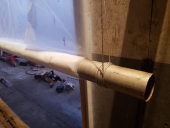I'll qualify what I'm going to say ...
I had a glassblowing studio from the late 1990s until the 2007/8 financial crash and did (and sometimes still do) a good bit of work on glass chemistry.
There's even a glass named after me, Brossphate, because I was able to sort the problems glassblowers had forever with getting phosphate glasses to melt smooth without chunks of crystals in the glass. Originally that was overcome with a high percentage of lead. My main desire in going deep on glass chemistry was to eliminate as many toxins like lead as possible.
https://www.davebross.com/GlassTech/whatarefurnacebeads.html
https://www.davebross.com/sitemap.html
Many furnace glassblowers have done production lines with recycled glass but it's difficult to work, requires additives, and will never be "crystal" pretty as a clear glass.
A LOT of "third world" glassblowers use recycled glass and cooking/drain oil to heat the furnaces and tough it out with the difficult working characteristics.
In spite of all they're working against they make some awesomely creative stuff.
https://www.voanews.com/a/kenyan-company-turns-glass-waste-into-artisanal-products/7936413.html
The sea glass market was flooded years ago and selling it would be difficult.
It takes a LONG time to tumble out a load of glass. I used to finish my furnace glass beads that way and it was tedious.
One of the problems with glass and glass as concrete aggregate and the like is that it will devitrify and become fragile. Glass is sand, alkali and modifier, the modifier being lime, zinc, or a few other things.
If the glass was formulated without enough modifier (not uncommon) the alkali will dissolve out of the glass, leaving a fragile skeleton of silica that will crush easily. That escaped alkali would be a mess in concrete. You could make it work but every batch of glass would have to be tested for possibility of devitrification.
If you try melting glass don't do it in a graphite crucible like one of the vids here. At full melt temps it's likely to foam and boil over. Use clay crucibles which are available from mine supply and assay outfits.
On the positive side, recycled glass can be remelted for utility items a number of times. The problem is the sheer volume of recycled glass out there.
I worked for a recycling outfit in Seattle in the 1990s and a good bit was able to be used by the Ball canning jar factory there if it was sorted correctly. The rest piled up until they had to landfill it.
The reason plastic took over from glass was shipping weight.
We could do worse than to put deposits back on glass bottles and mandate glass packaging. I think Oregon still does this.
I'm loving all the pics that were posted. Wonderful creativity!








